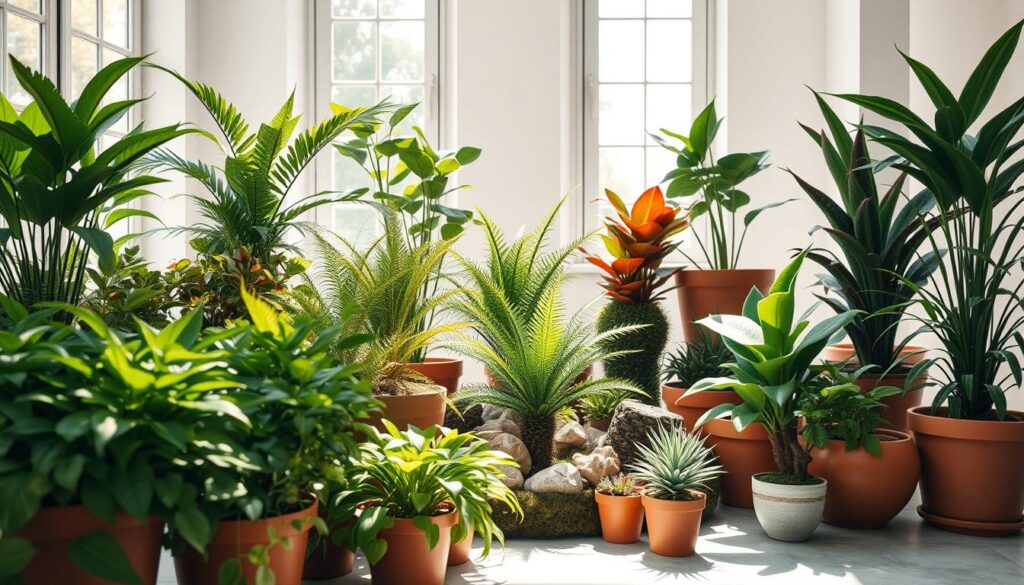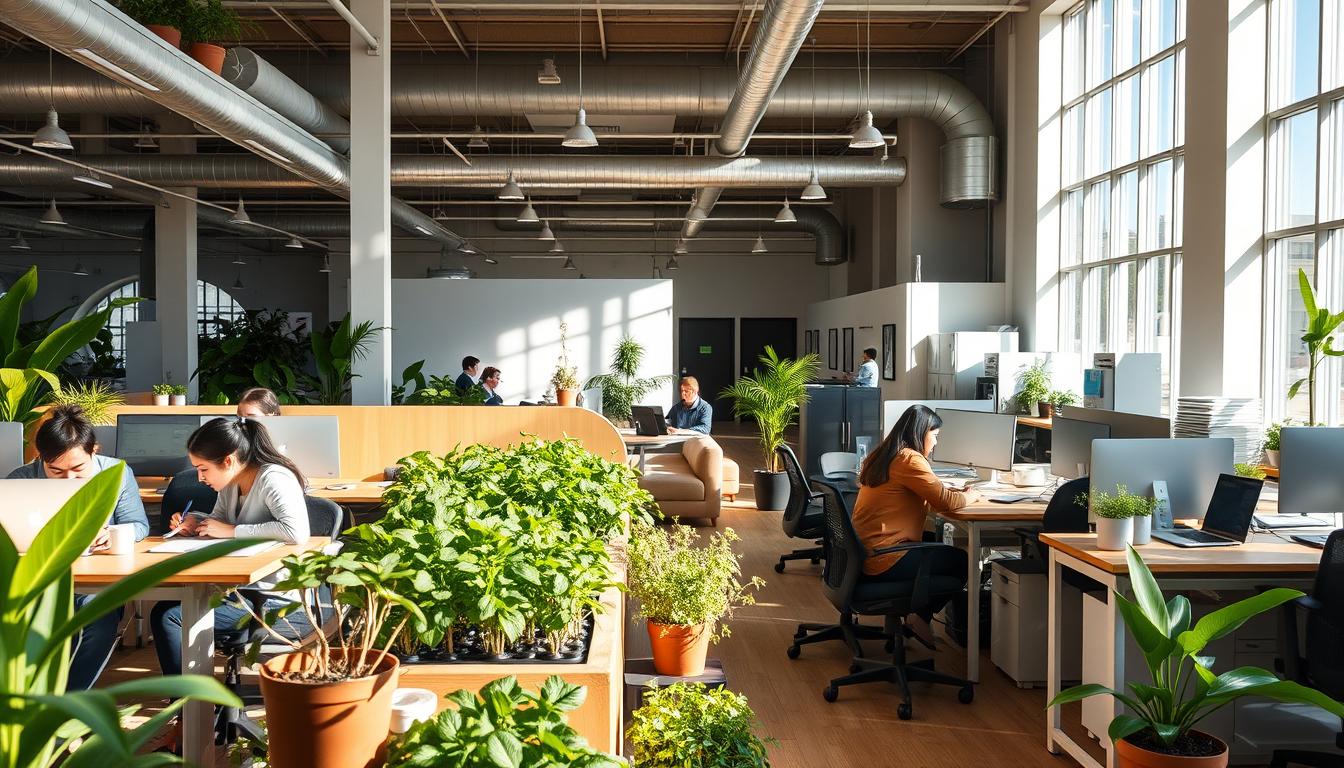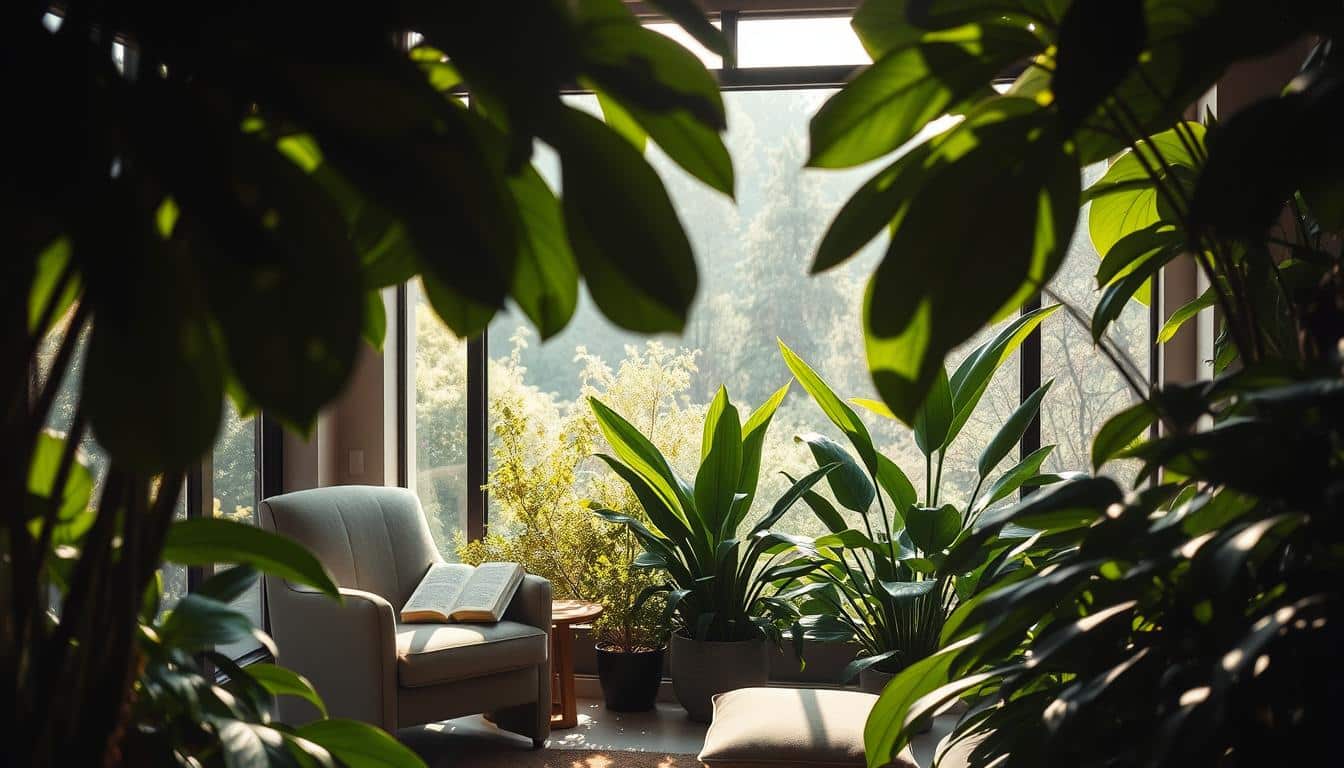Potted plants do more than just look nice. They play a big role in cleaning the air inside. They help by taking in bad air and giving out clean air.
They also take in carbon dioxide, which is important for making living spaces healthier. Learning about these benefits helps get more potted plants in cities and homes. This makes for a greener and better world.
Introduction to Potted Plants and Their Impact on the Environment
Potted plants are getting more popular, especially in cities, where they make a big difference. They’re not just for looks; they also help keep the indoor environment healthy. These plants beautify spaces and have key roles indoors.
Indoor plants are great for cleaning the air. Studies have shown they can take in bad substances like VOCs. These harmful compounds come from things like furniture and cleaners. By absorbing them, plants make the air inside better for us.
Indoor plants do more than just clean the air. They also make us feel better by lowering stress and boosting mood. This shows how important potted plants have become for making our living areas both nice and healthy.

Understanding the Role of Potted Plants in Indoor Air Quality
Potted plants play a key role in making indoor air better. They absorb bad pollutants and make oxygen through photosynthesis. Many studies show how some plants are really good at taking away harmful stuff like benzene and formaldehyde from the air.
Having potted plants around helps clean the air, which is great for our health. Cleaner air means we’re less stressed, can focus better, and work more efficiently. Adding plants to indoor spaces makes them healthier places to be.
To get the most out of plants for cleaning the air, choosing the right types is important. Spider plants, peace lilies, and snake plants are top picks. They’re really good at removing toxins from the air.
Potted Plants as Environmental Regulators
Potted plants are key to better air quality and health indoors. They remove harmful toxins and add moisture, making our living spaces healthier. Knowing how they help makes us value these natural purifiers even more.
How Potted Plants Improve Air Quality
Potted plants do a lot for cleaner air. They take in pollutants like formaldehyde and benzene and give out oxygen. Spider plants and peace lilies are great at cleaning the air. They also add moisture, which helps in dry places.
Plants’ Role in Carbon Dioxide Absorption
Potted plants also play a big part in taking in carbon dioxide. They turn CO2 into oxygen, vital for breathing well. Ferns and devil’s ivy are good at this, improving the air where we live. They show how crucial plants are for a healthier environment.
Light: The Essential Factor for Healthy Potted Plants
Light is key for potted plants to grow well. It helps them make food and stay healthy indoors. The amount, type, and length of light all play a part in this process.
Quantity of Light and Its Effects on Growth
How much light a plant gets is super important. Enough light helps plants create energy through photosynthesis. If they don’t get enough, they might grow weak and not flower well. It’s crucial to find the right balance of light.
Quality of Light: Which Colors Do Plants Need?
The type of light, or its color, really matters to plants. For example, blue light makes plants grow big leaves. Red light, however, is great for when plants are ready to flower or make fruit. This info helps us set up indoor lights to best help our plants.
Duration of Light: How Photoperiod Affects Flowering
The amount of time plants spend in light affects their health too. Some plants need long days to start making flowers. Others might need shorter days. Knowing what each plant prefers helps them grow better and flower on time.
Temperature and Humidity: Influencing Factors for Growth
Temperature and humidity are very important for potted plants’ health. Knowing about these helps you take care of plants inside. This ensures your plants do well where they are placed.
Impact of Temperature on Photosynthesis and Growth
Plants react differently to temperature. Each type of plant has a preferred temperature for making food and breathing. When it gets too hot, a plant breathes faster than it can make food. This slows down its growth and can hurt the plant. Checking the room’s temperature often keeps plants happy.
Importance of Humidity in a Plant’s Environment
Humidity is key for indoor plants’ health. High humidity helps plants keep water, which is good for them. But, low humidity can stress them out, causing problems. It’s important to keep air moist around plants, especially when it’s dry. You can use humidifiers or water trays to help with this.
Watering: A Critical Component of Potted Plant Care
Water is vital for potted plants. It helps with photosynthesis and moves nutrients around inside the plant. Good watering habits are crucial. They help the plant grow well without getting root rot or drying out.
The Role of Water in Photosynthesis and Nutrient Transport
Water is key for making food in plants through photosynthesis. It turns light into chemical energy. Water also carries important nutrients to all parts of the plant. Without enough water, plants can’t get the nutrients they need. This makes them weak.
How to Maintain Proper Soil Moisture Levels
Understanding the water needs of different plants helps keep the soil moist. Some ways to do this include:
- Use a moisture meter or your finger to check the soil.
- Water deeply when the soil dries out to help roots grow strong.
- Change how often you water based on the weather and air moisture.
- Make sure pots drain well to stop roots from sitting in water.
It’s important to know when a plant has too much or too little water. Signs include leaves that turn yellow, wilting, or drooping. Following these watering tips helps plants stay healthy and live longer.
Nutrient Requirements for Thriving Potted Plants
Potted plants do well if they get the right nutrients. Knowing the mix of big and small nutrients is key to keep them healthy. These nutrients help plants live, grow strong, and produce well.
Macro and Micronutrients Essential for Plant Health
For best growth, plants need both big and small nutrients. Important big nutrients are:
- Nitrogen: Key for leaf growth and strong plants.
- Phosphorus: Helps with roots and flowers.
- Potassium: Fights diseases and boosts fruit quality.
Small nutrients are also critical, even in tiny amounts. Necessary small nutrients are:
- Iron: Needed for green leaves and sun food making.
- Zinc: Keeps cells dividing and growing well.
- Manganese: Helps with enzymes and making sun food.
Signs Your Potted Plants Are Nutrient Deficient
Watching your plants helps catch nutrient problems early. Look out for these signs:
- Yellow leaves at the bottom mean not enough nitrogen.
- Not enough flowers or fruit points to low phosphorus.
- Leaves curling or edges turning brown show potassium lack.
- Not growing well and pale leaves suggest not enough small nutrients.
Knowing these signs helps you feed your plants right. This way, you get strong, healthy, and beautiful potted plants.
Common Environmental Stresses Affecting Potted Plants
Environmental stress can really impact how well potted plants grow. Not getting the right light, changing temperatures, and different levels of humidity can stress plants out. If you know these stress signs, you can help your plants. Learning to spot and fix these issues means your plants can do their best.
Identifying Stress Symptoms in Houseplants
Common plant stress symptoms include:
- Wilting leaves
- Brown leaf edges
- Yellowing foliage
- Unexpected leaf drop
- Stunted growth
These signs tell you your plant is stressed. Watching your plants closely helps you notice these signs early. Then, you can do something to help them quickly.
Strategies for Mitigating Environmental Stress
There are good ways to reduce stress on your plants and help them grow strong. Here are some tips:
- Adjust watering practices based on the specific needs of each plant.
- Monitor light conditions and relocate plants if necessary.
- Regulate temperature and humidity to create an optimal growing environment.
- Isolate stressed plants to prevent the spread of potential issues.
By following these tips, you can lower the stress your plants face. This leads to healthier and tougher houseplants.
The Importance of Pot Size and Drainage for Plant Health
Choosing the right pot size is key for healthy potted plants. A too small pot limits roots, making it hard for plants to get nutrients. This can stress them. A good-sized pot lets roots grow and helps plants absorb nutrients better. This leads to healthier growth.
Good drainage is super important for plant health. If pots don’t drain well, water can build up. This can cause root rot, which is really bad for plants. Use pots with holes or add gravel to help water escape and keep your plants happy.
When picking a pot, think about the plant’s needs. Some plants need big pots for their roots, while others do fine in smaller ones. Knowing your plant’s needs helps you choose the right size and ensure good drainage.
Using Growth Regulators to Enhance Potted Plant Growth
Plant growth regulators are key for healthy potted plants. They can come from natural or man-made sources. When used right, they make plants stronger and more colorful.
Types of Plant Hormones and Their Functions
Plant hormones help plants in different ways. Here are some important ones:
- Ethylene: This gas helps fruit ripen and influences when flowers bloom.
- Gibberellins: They make the stem grow longer, leading to taller plants.
- Auxins: Auxins are crucial for growth in roots and shoots.
How to Apply Growth Regulators Effectively
To use growth regulators well, you need the right approach. Here are some methods:
- Foliar Sprays: Spraying the leaves with hormones can quickly improve the plant.
- Soil Drenches: Putting growth regulators in the soil helps the whole plant grow better.
Benefits of Incorporating Potted Plants in Urban Spaces
Urban gardening is becoming popular among people living in cities. They want to make the most out of small spaces. Adding potted plants to urban areas has many benefits. It makes the area look better and the environment healthier. Green plants help clean the air, which is great for cities filled with concrete.
Potted plants help cool down cities. They do this by releasing water into the air. This makes hot, crowded places feel nicer. Plus, they clean the air by taking in pollutants. This leads to healthier places to live.
But, the good things don’t stop with cleaner air. Potted plants help increase the number of different living things in cities. They give a home to many creatures. They also bring people together by encouraging them to enjoy nature and each other. This can make everyone feel happier and make cities nicer to live in.
Having potted plants in cities makes them more beautiful. It reminds us of our link to nature. This makes city life better for everyone.
Conclusion
Potted plants make our spaces better by improving the air we breathe. They help make our living areas healthier, boosting both our body and mind.
Adding potted plants to our homes and work areas does more than just look nice. They play a big part in cleaning the air and making it better to breathe. By knowing how to take care of them, we can use them more and help our cities be greener.
By using potted plants, we’re helping the future by making our personal and shared spaces better. Promoting indoor plants helps us all live in healthier places.



